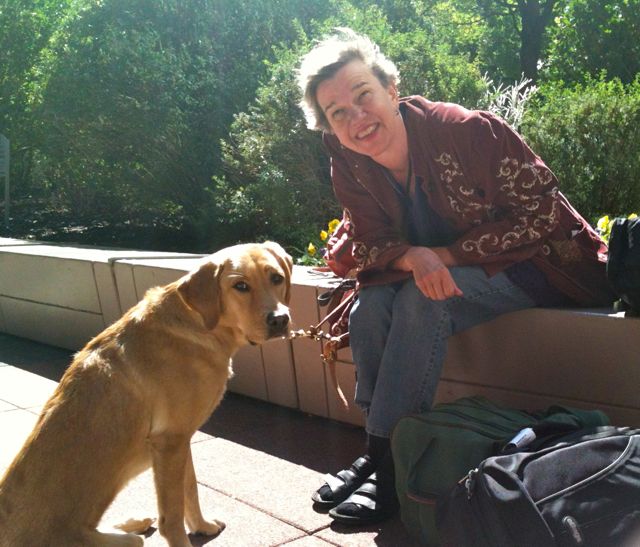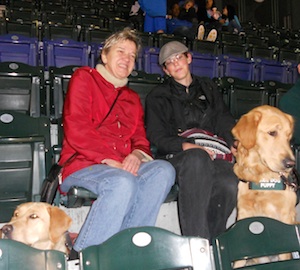Designed by Kayla
October 8, 2012 • 25 Comments • Posted in Beth Finke, blindness, Braille, careers/jobs for people who are blind, guide dogs, parenting a child with special needs, public speaking, Seeing Eye dogs, Uncategorized, visiting schools, Writing for ChildrenWhitney and I had a ball at the Youth Literature Festival in Champaign last week, and the highlight of the entire event was meeting Kayla, a delightful second grader at Westview
Elementary School. I usually don’t let kids pet Whitney when she has her harness on, but this was an exception. Kayla is blind, and she’d never been near a guide dog before. The only way for her to see how Whitney’s harness works was to touch it.
This spunky little sprite slid right down to the floor to feel Whitney’s ears, too. And her tail. And her back. And her belly. At one point they were face-to-face. “She’s staring at me!” Kayla exclaimed in delight. “That means she likes me.”
It was true. And really, who wouldn’t like Kayla? The two of us had just met, and already I was learning a lot from her. “That must be why people stare at us sometimes,” I said with a laugh. “They like us, too!”
Before we visited Kayla’s school, Whitney and I had been treated to lunch with faculty, students and staff working on Special Friends, and they explained how the six-week program works to help average kids understand and appreciate children with disabilities.
For all six weeks, kindergarten teachers read stories about children with disabilities to their students three times a week. The Special Friends kindergarteners enjoy a 15- minute learning activity about disabilities three times a week, too. And then, the kids take home one of the books they read in class every week to read and discuss with family members. After this six-week concentration on disabilities, the Special Friends people I had lunch with Friday keep track of the kindergartners to determine the short- and long-term effects of this six-week program.
Westview Elementary, where Kayla goes to school, is one of the schools participating in Special Friends. If Kayla’s confidence and self-assurance is any indication, I’d say the six-week program is an unqualified success. When I complimented Kayla’s mom on what a terrific job she is doing raising her daughter, the mom told me Kayla has visited a couple special education students in college classes to give talks. “She comes in, says she’s blind, shows off her white cane, talks about learning Braille and tells them why they oughta like her,” her mom said with a laugh. “And by the end of the session, they do!”
And that’s when I got the idea. I invited Kayla to help us with our presentation during the festival Community Day. And so there we were the next morning, Kayla in one seat, me in the other, Whitney sandwiched between us. When it came time for me to show the SRO crowd how I use the “outside” command to have Whitney guide me to a door, Kayla whipped out her white cane to demonstrate how she finds doors, too. When we returned to our seats, a boy in the audience asked Kayla if she was going to get a dog.
Kayla didn’t answer right away, so I butted in and explained that you have to be at least 16 years old to train with a Seeing Eye dog. The Seeing Eye believes working with a guide dog demands a certain amount of physical, mental, and emotional maturity.
“In order to work with a Seeing Eye dog, you have to be with the dog all the time. You have to be the one who feeds the dog, grooms the dog, takes the dog to the vet when you need to – not your mom or dad, not your brother or sister or your grandparents – you,” I said, explaining how that’s all part of the bonding, how it helps the dog understand how important it is to keep their blind companion safe. “You guys in elementary school and middle school are busy all day learning stuff,” I continued. “You don’t get enough breaks during school to take your dog out to empty or give them the walks they need.”
Kayla is a good listener. She understood, and she had an answer for the boy’s question now. “When I’m 16, I’m getting one,” she declared.
I read from a Braille version of Hanni and Beth: Safe & Sound to the audience, and then handed it to Kayla as a gift. ”Thank you!” she gushed, and as she busied herself running her fingertips over the pages, I answered questions and explained tricks I use to do things at home: stretching a rubber band over a bottle of conditioner to distinguish it from shampoo, putting safety pins on the tags of anything I wear that’s black (paper clips for white), choosing dresses and skirts made of unique fabrics and interesting textures so I can use my sense of touch to keep track of what I’m wearing.
And then came my favorite question of the morning. A kid in the back row asked, “Kayla, what do you want to be when you grow up?”
Kayla’s answer: a fashion designer. “I want to design dresses and skirts,” she told the audience. “I’ll give them to all the girls to make them look pretty.”



 Here's an excerpt:
Here's an excerpt: